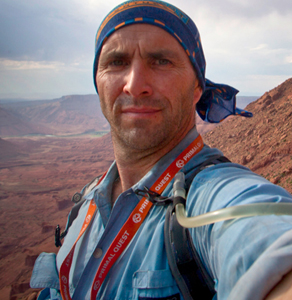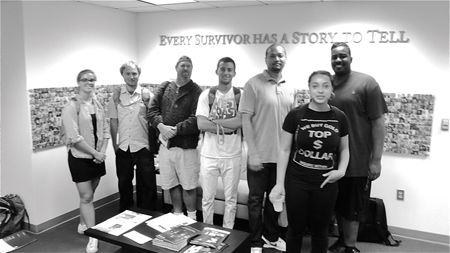
Tony Di Zinno
For Libero Antonio (Tony) Di Zinno and his photography students, visiting the USC Shoah Foundation last week was not just a chance to learn about the Visual History Archive and its 53,000 testimonies. It was also an opportunity to deeply explore their sense of purpose as global citizens and responsibility as visual storytellers.
Di Zinno is a photographer and professor at Art Center College of Design and Santa Monica City College (SMC) He met Shoah Foundation co-founding director James Moll on Moll’s documentary Running the Sahara, and said he continues to follow in Moll’s example as a story teller even today.
He is currently working on a project with the Oglala of the Great Sioux Nation in Pine Ridge, South Dakota, to initiate the Lakota youth in documentary photography and a book-making project to give voice to the native point of view as well as a create viable means of preserving the oral traditions.
He had just returned from meeting with tribal leaders when he received an invitation to USC Shoah Foundation’s 20th Anniversary Ambassadors for Humanity Gala. Di Zinno brought some of his fellow teachers from Art Center College of Design on the Institute’s next monthly public tour.
“The connection was obvious to me that these same subjects of living testimonials, genocide and storytelling were overlapping in my own personal and professional life,” Di Zinno said.
At the tour, Shoah Foundation staff invited Di Zinno to return with his students. He brought his SMC Video for Stills class, which introduces photographers to a visual narrative through motion media by way of the use of their HDSLR cameras as tools for storytelling.

At their next class meeting, Di Zinno said his students continued the conversation and brought up many questions to consider when shooting a documentary subject.
“First, what are we looking at as a subject? Why is it important? Secondly, where are you standing in relationship to the subject? Are you informed? Have you done the requisite research? Do you have access, permission and the blessings of the story tellers?” Di Zinno said. “Third, when is the precise moment you shoot? What is your point of view? Finally, at the end of the day, what did we learn and/or experience? And is it shared with the audience and viewers?”
Even more importantly, perhaps, the visit was an opportunity for his students to connect to human history and discover what they are most passionate about. Everyone in the class is given permission to follow their passions when directed in a meaningful way, Di Zinno said.
“To my way of thinking, if you are not outraged at the injustices in the world today you are simply not paying close enough attention to what is actually going on,” he said. “As global citizens we share this small blue planet together and we have to remember we are interdependent and interconnected.”
He believes it is vital for today’s young people to be informed about current events and history and, if possible, to reach them through visual media. Once students become sufficiently aware of what’s happening in the world, they can then begin to play a responsible and active role in global society.
“When we can connect them to their ancestry as fellow human beings to the Shoah or any genocide for that matter – in Rwanda, Armenia or even here in the American West – we reconnect them to a sense of higher purpose and their own voice. Then the very real possibility is awakened that what they have to say actually matters,” he said. “I trust that the seeds have been planted in these students to be attracted to the stories that move them deeply.”
For more information about the Lakota “Giving Voice” project, visit http://www.theunityconcert.com/ or email Di Zinno at [email protected] ,Twitter @tony_dizinno or Facebook Tony Di Zinno.